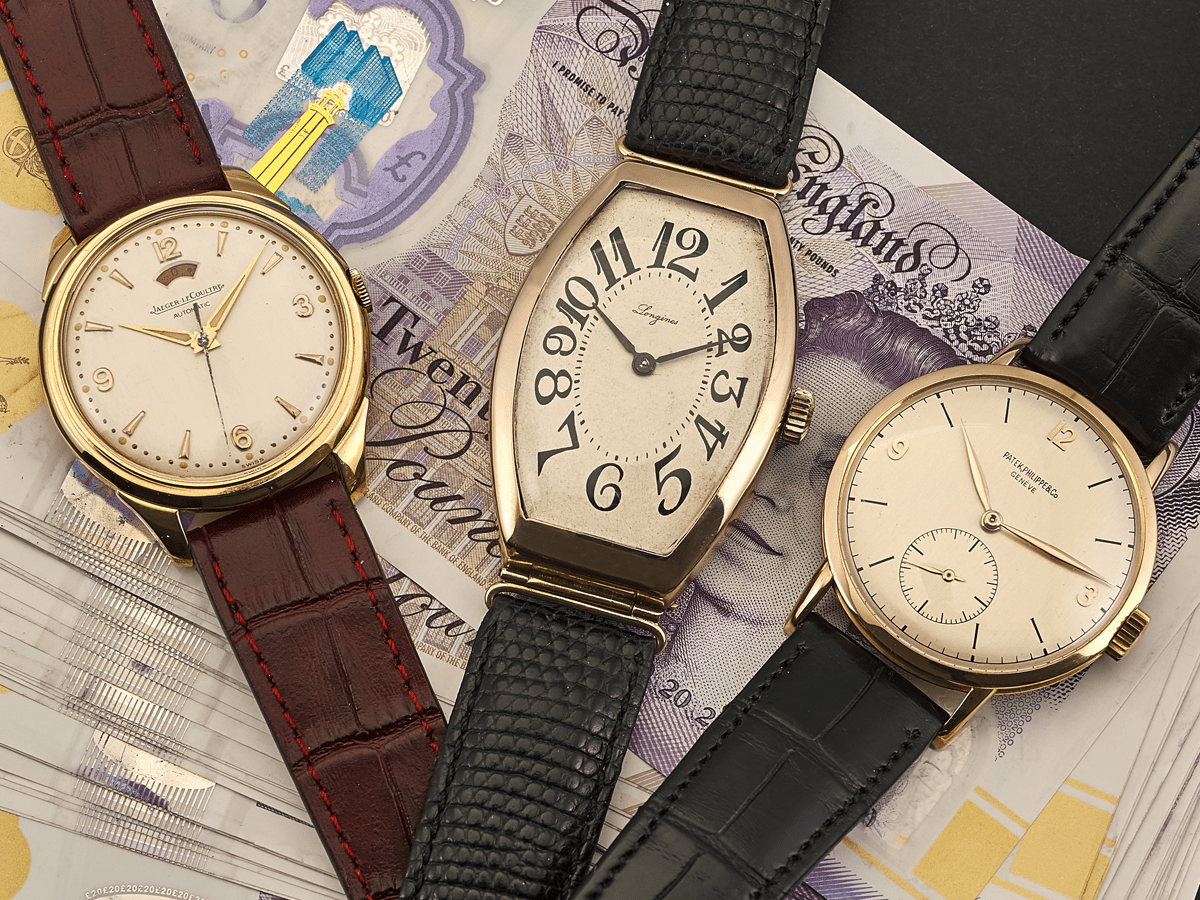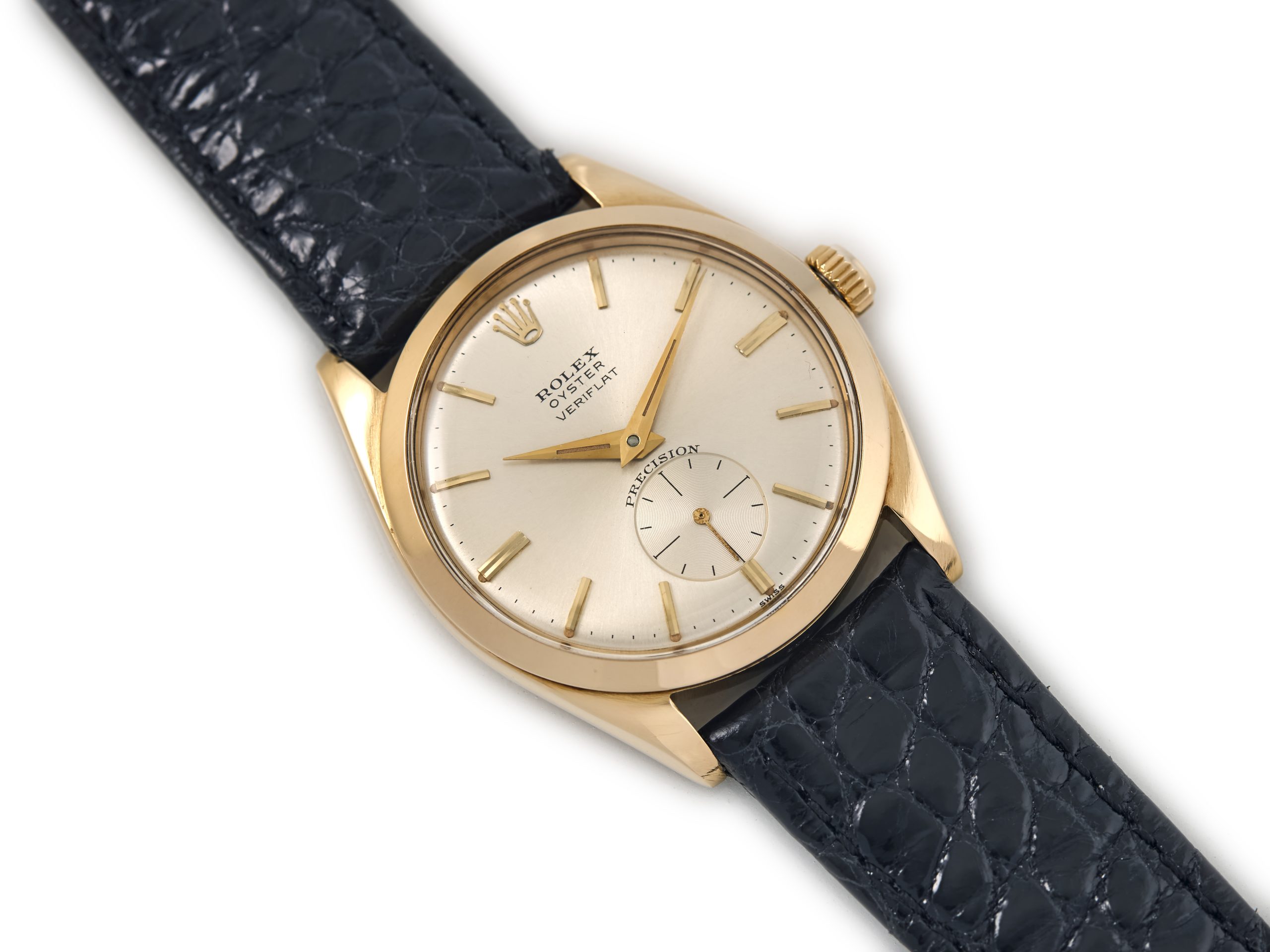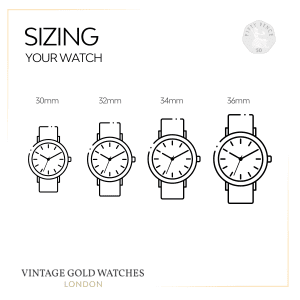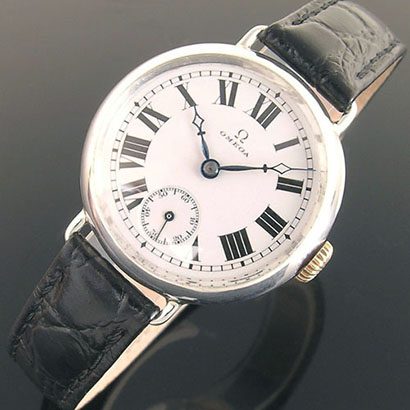WATCH SIZE GUIDE
Selecting the right-sized watch can seem like a daunting task for those unfamiliar with the intricacies of wristwatch sizing. If you’ve ever found yourself perplexed by how to measure watch sizes, you’re not alone.
Today, we’re here to simplify the process through this watch measurement guide, where our experts will guide you through the process of finding the perfect-sized wristwatch through easy-to-understand insights.

The Dilemma of Modern Watch Sizes
When it comes to wristwatches, a fascinating shift in style has occurred over the decades. While contemporary fashion trends have ushered in an era of large, bulky sports watches, the historical norm tells a different story.
For much of watchmaking history, the wristwatch dimensions hovered around 33 millimetres in diameter, with a slender depth of around 10 millimetres or less. These dimensions were not just a matter of practicality but a testament to the evolution of timekeeping fashion.
The first early wristwatches featured manual wound movements, meaning they didn’t require large case sizes to accommodate complex mechanisms. However, with the introduction of the first mechanical movement in the early 1930s, watch sizes slowly began to increase to accommodate these larger movements. This trend continued until larger sizes became the norm, reflecting both advancements in technology and shifts in consumer preferences.
Yet, amidst the allure of oversized watches, the practicality of such timepieces for everyday wear remains questionable. The reality is that the vast majority of wearers may never explore the mountain peaks and ocean depths these watches were engineered to withstand.
So, as you learn to size your wristwatch, remember that while larger watches may dominate the current trendscape, the timeless appeal of smaller, vintage designs endures—a testament to the enduring legacy of wristwatch craftsmanship.

Watch Case Size
When it comes to finding the perfect watch fit, understanding the dimensions of your timepiece is crucial. Here’s a comprehensive guide on how to measure your watch, ensuring a comfortable and stylish wear every time.
Measuring the Watch Case
To accurately measure the case size on a watch, you’ll need a reliable calliper and a steady hand. Make sure your calliper is in top condition, calibrated in the metric system (as watch measurements are typically in millimetres), and preferably digital for precision. Opt for callipers with plastic jaws to prevent any unwanted scratching.
For interior measurements, loosen the calliper, align the jaws with the area to be measured, and adjust until both exterior-facing jaws touch the watch. Once aligned, tighten the lock screw for an accurate reading. Conversely, for exterior measurements, use interior-facing jaws for precision.
Getting the Base Size
The base size of a watch is typically measured diagonally, avoiding the crown and other case features. This measurement, taken across the 8 to 2 marks, provides a foundational size for further adjustments.
Measuring Other Case Shapes
Different watch shapes require unique measurement approaches. A round watch wears differently than a cushion-shaped, rectangular, or square one. When measuring irregularly shaped cases, such as the Patek Philippe Nautilus with its cushion casing, focus on the narrowest point for accuracy. Consider recording measurements at both the narrowest and widest points to fully understand your watch’s dimensions.
Sizing a watch band becomes particularly important for those with larger wrists. Most women’s watches fall between 6.75″ to 7″, while men’s watches typically range from 7.5″ to 8″. Understanding strap length, often expressed as two numbers like 120/70mm, helps ensure a proper fit. The first number indicates the length of the long end in millimetres, while the second number represents the buckle end.
Width: Achieving the perfect balance in a timepiece involves more than just its case diameter. Typically, a well-proportioned watch will have a strap or band width of roughly 50% of its case diameter. Stray too far from this ratio, and your watch might appear out of sync with its design.
Length: Tailoring your watch band length to your wrist size ensures both comfort and style. Aim for a band length within a half-inch of your wrist’s circumference, factoring in the diameter and thickness of your case.
Material: The choice of band material also plays a pivotal role. Metal bands often impart a heftier and bulkier look compared to leather or fabric alternatives. Your selection should align with the desired aesthetic, occasion, and practicality. After all, a luxury watch isn’t just about looks—it’s about finding that perfect balance of form and function.
Other factors influencing how a watch wears include the type and width of the strap and details like stitching. Metal bracelets tend to appear more substantial than leather or fabric straps.
To determine your ideal band length, subtract the watch case size from your wrist length.
(30-mm // 36 for time only watches and some chronographs will go to 36 – 38 mm – fix graphic)
New sizes to represent would be
30mm 32mm 34mm 36mm

How To Measure Wrist Size For a Watch
In the world of timepieces, the terms “watch bands” in the US and “watch straps” in the UK are often used interchangeably, referring to the accessory that secures your watch to your wrist.
Here are some essential considerations when selecting and sizing your watch straps or bands:
Measure for a strap/band
Once armed with a tailor’s tape (only for leather or fabric straps), follow these steps to measure your wrist size for a watch:
- Start with your hand facing upward and your palm open.
- Place the metal tip of the tailor’s tape in the centre of your wrist.
- Wrap the tape around your wrist until it meets the metal tip. This measurement represents the circumference of your wrist. Note this number for selecting a properly fitted watch band.
Alternatively, if you’re without a tailor’s tape or if you’re sizing a metal bracelet, you can use a piece of paper through the following method:
- Use a strip of paper and wrap it around your wrist.
- Mark where the paper overlaps with the starting point.
- Measure the distance between the starting point and the mark using a ruler.
- While tools like wrist sizers exist, a tailor’s tape is versatile for various measurements.

Case Thickness
Often overlooked, case thickness plays a significant role in watch comfort. Many of us are used to modern, bulky sports watches which have very thick cases. A typical vintage dress watch might have a case thickness of 10 millimetres, while modern sports watches could range from 15 to even 20 millimetres in depth.
Most watches fall within the 8-12mm range, with thin and ultra-thin models measuring less than 8mm and thicker watches exceeding 14mm. Ideally, the depth of the case should complement its diameter, ensuring a harmonious fit on your wrist. For smaller to medium-sized cases, expect a thickness of around 7mm, while larger cases typically hover around 9mm.
Finding the right balance between diameter and thickness ensures not only a comfortable wear but also a sleek and stylish look on your wrist.
(gold watch, vintage thinner, not steel))

Lugs
Watch lugs are those little ‘horns’ where the case connects to the strap or bracelet. They might not be factored into the case diameter, so they can stick out further. Make sure to leave some breathing room when measuring your wrist to accommodate the lugs, or else they could extend out and make your watch uncomfortable to wear.
Measuring the lug width is just as vital as measuring the casing. Without this information, buying replacement bands or bracelets becomes a guessing game. To measure the lug width, use the exterior-facing jaws of a calliper to measure the inside of the lug.
Now, measuring the distance between the lugs is equally important. Use the interior-facing jaws of the calliper between two parallel lugs on either side of the watch. Understanding this, along with your wrist’s shape—whether it’s flatter or more rounded—will help you determine if the watch will sit comfortably or if it’s not the right fit for you.
Choosing the perfect watch size involves several factors, from personal style preferences to wrist size and watch depth. Here’s a simple guide to help you find the ideal fit:
1. Decide on Your Preferred Style
Begin by deciding on the style of watch that appeals to you. For those seeking elegance, a dress watch in the range of 34mm to 36mm is often the most suitable choice. If you have slightly smaller wrists, consider sizes around 30mm to 32mm. Conversely, individuals with larger wrists may find chronograph watches, which tend to be larger and more fitting. Traditionally, chronographs are around 38mm in diameter, catering to wrists around 6 and three-quarter inches in circumference.
2. Measure Your Wrist
Before selecting a watch size, it’s essential to measure your wrist accurately. While a tape measure suffices for measuring wrist circumference for straps, using a piece of paper and a ruler provides more precise measurements for bracelets.
3. Consider the Depth of the Watch
Consider the watch’s depth, especially if you opt for an automatic timepiece. Due to the size of the movement (including a rotor), automatic watches are typically deeper. A dress watch might have a depth of 8mm to 10mm, while an automatic could range from 12mm to 15mm.
4. Choose a Band or Strap Size
When choosing between a leather strap and a bracelet, consider adjustability. Leather straps offer more flexibility in fit, whereas bracelets often have limited adjustment options. Some bracelets may require tailoring for a perfect fit, so the limited adjustability needs to be taken into consideration when selecting your watch.
FAQs
How should a watch fit?
A watch should fit comfortably on your wrist, with the strap or bracelet snug enough to prevent excessive movement but not so tight as to cause discomfort. It’s essential to find a balance that allows for flexibility in various conditions. In colder weather, you may need to wear the watch slightly tighter to prevent it from slipping around, while in hotter conditions, some slack can help alleviate discomfort caused by swelling.
What wrist do you wear a watch on?
Typically, the rule of thumb is to wear your watch on your non-dominant hand. This tradition originated from the fact that people needed their dominant hand to wind manual watches. So, for example, if you’re right-handed, you would wear your watch on your left wrist, and vice versa.
Where should a watch sit on your wrist?
The placement of a watch on the wrist can vary based on personal preference and style. Some individuals prefer to wear their watch right on the end of the wrist, which can be comfortable and also helps showcase the timepiece, especially when not hidden by a cuff. However, it’s more common for the watch to sit partly hidden by the cuff further up the arm, typically a few inches from the hand. This positioning provides a balance between functionality and aesthetics, allowing for easy viewing of the watch while maintaining a sophisticated appearance when wearing long sleeves.
On what wrist should a man wear a watch?
Traditionally, men wear their watches on the left wrist. This practice is rooted in historical reasons, particularly the ease of winding watches with the dominant hand. However, ultimately, it’s a matter of personal preference, and some men may choose to wear their watches on their right wrist instead.
On what wrist should a woman wear a watch?
Similar to men, women typically wear their watches on the left wrist as well. This convention aligns with historical practices and is based on considerations like ease of winding watches with the dominant hand. However, as with men, the choice ultimately depends on personal preference.






